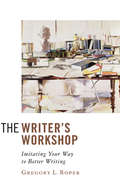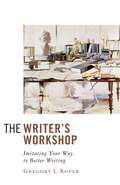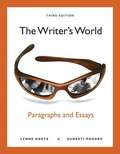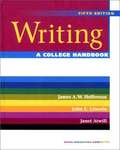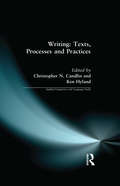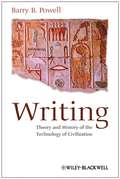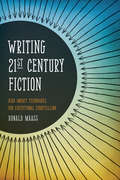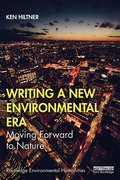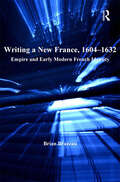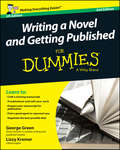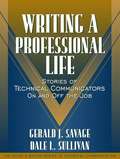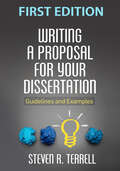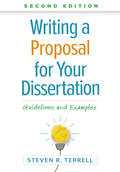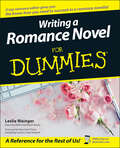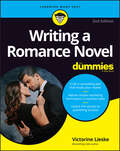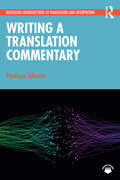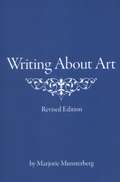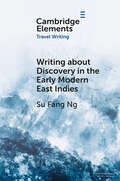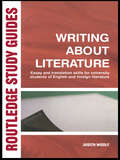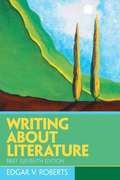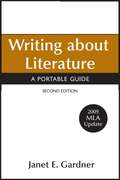- Table View
- List View
The Writer's Workshop: Imitating Your Way to Better Writing
by Gregory L. RoperThe Writer’s Workshop takes an approach to teaching writing that is new only because it is so old. Today, rhetoric and composition typically proceed by ignoring what was done for 2,500 years in Western education. Gregory Roper, on the other hand, helps students learn to write in the way the great writers of the past themselves learned: by carefully imitating masters of the craft, including Cicero, Thomas Aquinas, Charles Dickens, Sojourner Truth, James Joyce, and Ernest Hemingway. By living in their workshops and apprenticing to these and other masters, apprentice writers—like apprentice musicians, painters, and blacksmiths of the past—will rapidly improve the complexity of their art and discover their own native voices.Interspersed into chapters full of sound practical advice and challenging assignments are reflections on Great Ideas from “Realism and Impressionism” to “Nominalism and Modern Science.” Perfect for the college or even high school writing classroom—as well as a marvelous book for homeschoolers and others who would like to improve their own writing—The Writer’s Workshop is a fine practical guide, and Dr. Roper a friendly yet demanding teacher-mentor.
The Writer's Workshop: Imitating Your Way to Better Writing
by Gregory L. RoperThe Writer's Workshop takes an approach to teaching writing that is new only because it is so old. Today, rhetoric and composition typically proceed by ignoring what was done for 2,500 years in Western education. Gregory Roper, on the other hand, helps students learn to write in the way the great writers of the past themselves learned: by carefully imitating masters of the craft, including Cicero, Thomas Aquinas, Charles Dickens, Sojourner Truth, James Joyce, and Ernest Hemingway. By living in their workshops and apprenticing to these and other masters, apprentice writers—like apprentice musicians, painters, and blacksmiths of the past—will rapidly improve the complexity of their art and discover their own native voices. Interspersed into chapters full of sound practical advice and challenging assignments are reflections on Great Ideas from "Realism and Impressionism" to "Nominalism and Modern Science." Perfect for the college or even high school writing classroom—as well as a marvelous book for homeschoolers and others who would like to improve their own writing—The Writer's Workshop is a fine practical guide, and Dr. Roper a friendly yet demanding teacher-mentor.
The Writer's World: Paragraphs and Essays (3rd Edition)
by Lynne Gaetz Suneeti PhadkeThe Writer's World series was written to address the diverse needs of today's students: students whose first language is not English, students who respond favorably to visuals, and students who have varying skill levels.
Writing: A Guide for College and Beyond, Fourth Edition
by Lester FaigleyFor college courses in Composition and Rhetoric. Revealing the writing process through interactive learning Writing: A Guide for College and Beyond presents writing, reading, and research processes dynamically, using a variety of visuals to illustrate how readers interact with texts and how writers compose. One of the first textbook authors to focus on multimedia composing, Lester Faigley employs his own advice to engage students in every step of the writing process-for both college composition and everyday life-and pulls back the curtain on how writers work. Aligned with the learning goals for a first-year college writing course identified in the 2014 Outcomes Statement from the Council of Writing Program Administrators, Writing: A Guide for College and Beyond gives students the support they need to succeed in first-year composition, in their other courses, and in their careers. In the Fourth Edition, students can also practice and explore what they've learned chapter-by-chapter with interactive MyWritingLab tools, assignments and projects. Also available with MyWritingLab(tm) This text is also available with MyWritingLab(tm) - an online homework, tutorial, and assessment program designed to work with this text to engage students and improve results. Within its structured environment, students practice what they learn, test their understanding, and pursue a personalized study plan that helps them better absorb course material and understand difficult concepts.
Writing: A College Handbook (5th edition)
by James A. W. Hefferman John E. Lincoln Janet AtwillThe Fifth Edition exemplifies in clear, engaging prose the skills that students need to communicate in a wide variety of rhetorical contexts. A reliable and easy-to-use reference tool and an up-to-date rhetoric and research guide, Writing: A College Handbook invites students to discover the power of effective writing.
Writing: Texts, Processes and Practices (Applied Linguistics and Language Study)
by Ken Hyland Christopher N. CandlinWriting: Texts, Processes and Practices offers an innovative and multidisciplinary approach to writing in a variety of academic and professional settings. The book is composed of a series of original research-based accounts by leading authorities from a range of disciplines. The papers are linked through a unifying perspective which emphasises the role of cultural and institutional practices in the construction and interpretation of written texts.This important new book integrates different approaches to text analysis, different perspectives on writing processes, and the different methodologies used to research written texts. Throughout,an explicit link is made between research and practice illustrated with reference to a number of case studies drawn from professional and classroom contexts.The book will be of considerable interest to those concerned with professional or academic writing and will be of particular value to students and lecturers in applied linguistics, communication studies, discourse analysis, and professional communications training.The contributors to this volume are: Robert J. BarrettVijay K. BhatiaChristopher N. CandlinYu-Ying ChangSandra GollinKen HylandRoz IvanicMary R. LeaIan G. MalcolmJohn MiltonGreg MyersGuenter A. PlumBrian StreetJohn M. SwalesSue WeldonPatricia Wright
Writing
by Barry B. PowellWriting: Theory and History of the Technology of Civilization traces the origins of writing tied to speech from ancient Sumer through the Greek alphabet and beyond. Examines the earliest evidence for writing in Mesopotamia in the fourth millennium BC, the origins of purely phonographic systems, and the mystery of alphabetic writing Includes discussions of Ancient Egyptian,Chinese, and Mayan writing Shows how the structures of writing served and do serve social needs and in turn create patterns of social behavior Clarifies the argument with many illustrations
Writing: The Nature, Development, and Teaching of Written Communication
by M. Farr WhitemanFirst Published in 1982. Routledge is an imprint of Taylor & Francis, an informa company.
Writing 21st Century Fiction: High Impact Techniques for Exceptional Storytelling
by Donald MaassWhat is it that makes twenty-first century fiction different from twentieth century fiction? It's a real issue, attested by slush piles that are chock full of stories that are weak and lifeless. The writing is old-fashioned and stale, crafted by authors following outmoded and stifling "rules" once thought necessary in order to get published. Author and literary agent Donald Maass eliminates that restrictive philosophy by deconstructing the techniques used to craft successful (often best-selling) recent novels. He'll push you beyond the boundaries of genre, beyond outdated styles, and beyond your safety zones. You'll discover new ways of writing fiction that are personal, unique, and contemporary, resulting in fiction that is both literaryandcommercial.
Writing a New Environmental Era: Moving forward to nature (Routledge Environmental Humanities)
by Ken HiltnerWriting a New Environmental Era first considers and then rejects back-to-nature thinking and its proponents like Henry David Thoreau, arguing that human beings have never lived at peace with nature. Consequently, we need to stop thinking about going back to what never was and instead work at moving forward to forge a more harmonious relationship with nature in the future. Using the rise of the automobile and climate change denial literature to explore how our current environmental era was written into existence, Ken Hiltner argues that the humanities—and not, as might be expected, the sciences—need to lead us there. In one sense, climate change is caused by a rise in atmospheric CO2 and other so-called greenhouse gases. Science can address this cause. However, approached in another way altogether, climate change is caused by a range of troubling human activities that require the release of these gases, such as our obsessions with cars, lavish houses, air travel and endless consumer goods. The natural sciences may be able to tell us how these activities are changing our climate, but not why we are engaging in them. That’s a job for the humanities and social sciences. As this book argues, we need to see anthropogenic (i.e. human-caused) climate change for what it is and address it as such: a human problem brought about by human actions. A passionate and personal exploration of why the Environmental Humanities matter and why we should be looking forward, not back to nature, this book will be essential reading for all those interested in the future and sustainability of our planet.
Writing a New France, 1604-1632: Empire and Early Modern French Identity (Transculturalisms, 1400-1700)
by Brian BrazeauThe focus of this study is the exciting period of French overseas exploration directly following the stagnation caused by the Wars of Religion. The book examines the early period of French involvement in Northeastern America through readings of key texts, principally travel and missionary accounts. Among the works examined are travel writings by Marc Lescarbot (Histoire de la Nouvelle-France) and Samuel de Champlain (Voyages), and missionary works by Gabriel Sagard (Dictionnaire de la Langue Huronne, Histoire du Canada), Jean de Brébeuf, and Paul le Jeune (early Relations de Jésuites). Through a careful examination of these texts, the author discerns a French "rewriting of the self" in relation to the American other, represented by both land and people. America, Brazeau argues, allowed a consolidation of past markers of identity, and forced a radical rereading of others, due to the difficulties presented by the Canadian wilderness and its natives. Writing a New France, 1604-1632 sheds fresh light on a significant moment in French colonial history while providing an innovative contribution to the understanding of early modern French identity and cultural contact.
Writing a Novel and Getting Published For Dummies UK
by George Green Lizzy E. KremerLearn to: Craft a winning manuscript Troubleshoot and edit your work Prepare your manuscript for publication Find a good agent to represent you Negotiate the best possible deal Turn your aspiration into reality with this completely updated guide If you’ve always wanted to write that great novel, but never knew where to start, look no further! With a published author advising you on how to write well and a literary agent providing insight into getting a publishing deal, this updated guide gives you the inside track on the art and science of breaking into the fiction-publishing industry. Taking you step by step from concept to contract, this book provides the tools you need to tell your story with skill and approach agents and publishers with confidence. Dive in — check out how to combine your natural talent with the writing techniques used by successful authors Establish a firm foundation — construct your basic story, plot and structure Examine the key elements — create characters, develop dialogue, explore relationships and insert conflict Fine-tune and finish up — discover tips on adding detail, creativity and flair while bringing your work to a close Get published — take the next step by weighing up your publishing options, working with agents and negotiating deals Find out more — check out additional advice, like the most common mistakes you need to avoid, and tips from published authors Open the book and find: Tips for getting started Creative ways to develop plots, storylines, characters and dialogue The seven basic stories and how to put them to work Tricks for crafting a great ending to your novel How to prepare your manuscript for editing and publishing The lowdown on the business side of publishing
Writing a Professional Life: Stories of Technical Communicators On and Off the Job
by Gerald J. Savage Dale L. SullivanThis is the first collection of narratives by practicing technical communicators telling their own personal stories about the workplace and their lives on the job. The authors portray a wide range of jobs: writers, editors, interface designers, marketing writers, and trainers working in 9 different technical fields, including software, R&D, engineering , medicine, transportation, and telecommunications. The stories vividly demonstrate the unique power of narrative as a teaching and learning tool. Unlike fabricated cases, these real-life narratives show new and veteran technical writers at work on the job, dealing with tasks, clients, and co-workers, and revealing their insights, values, and attitudes about their work. The stories also show the skills required in the profession and the ethical and other issues raised in the course of the workday. For anyone interested in technical communication and professional writing.
Writing a Proposal for Your Dissertation
by Steven R. TerrellThis user-friendly guide helps students get started on--and complete--a successful doctoral dissertation proposal by accessibly explaining the process and breaking it down into manageable steps. Steven R. Terrell demonstrates how to write each chapter of the proposal, including the problem statement, purpose statement, and research questions and hypotheses; literature review; and detailed plan for data collection and analysis. Of special utility, end-of-chapter exercises serve as building blocks for developing a full draft of an original proposal. Numerous case study examples are drawn from across the social, behavioral, and health science disciplines. Appendices present an exemplary proposal written three ways to encompass quantitative, qualitative, and mixed-methods designs. Pedagogical Features: *"Let's Start Writing" exercises leading up to a complete proposal draft. *"Do You Understand?" checklists of key terms plus an end-of-book glossary. *End-of-chapter quizzes with answers. *Case study examples from education, psychology, health sciences, business, and information systems. *Sample proposal with three variants of the methods chapter: quantitative, qualitative, and mixed methods.
Writing a Proposal for Your Dissertation: Guidelines and Examples
by Steven R. TerrellThe encouraging book that has guided thousands of students step by step through crafting a strong dissertation proposal is now in a thoroughly revised second edition. It includes new guidance for developing methodology-specific problem statements, an expanded discussion of the literature review, coverage of the four-chapter dissertation model, and more. Terrell demonstrates how to write each chapter of the proposal, including the problem statement, purpose statement, and research questions and hypotheses; literature review; and detailed plans for data collection and analysis. "Let's Start Writing" exercises serve as building blocks for drafting a complete proposal. Other user-friendly features include case-study examples from diverse disciplines, &“Do You Understand?&” checklists, and end-of-chapter practice tests with answers. Appendices present an exemplary proposal written three ways to demonstrate quantitative, qualitative, and mixed methods approaches, and discuss how to structure a four-chapter dissertation. New to This Edition *Introduction offering a concise overview of the entire proposal-writing process and the doctoral experience. *Additional help with tailoring problem and purpose statements for quantitative, qualitative, and mixed-methods studies. *Expanded discussion of the review of literature, including a criterion for judging the quality of primary versus secondary sources. *Many new examples from different disciplines, such as studies of depression treatments, approaches to reducing offender recidivism, health effects of irradiated crops, strength training in college football, and remote teaching and learning during COVID-19. *Focus on the five-chapter model is broadened to include specific guidance for four-chapter dissertations. *Broader, more detailed reference list and glossary.
Writing a Romance Novel For Dummies
by Leslie WaingerIn love with romance novels? You’re not alone! Romance is today’s most popular fiction genre, accounting for more than half of all mass market fiction sold. If you’re looking to make a serious effort at writing a romance and getting it published in today’s multifaceted markets, you need to learn as much as you can about this highly successful field—especially how to create the perfect heroes and heroines. Now, in this easy, step-by-step guide, a top romance editor gives you the know-how you need to succeed as a romance novelist! Writing A Romance Novel For Dummies is perfect for both beginning and more accomplished writers who are looking to get the leading edge on writing a romance novel and get it published. Leslie Wainger, Executive Editor at Harlequin Books, explains what it takes to become the next Nora Roberts, providing the techniques you need to: Select a pseudonym Write a compelling, heartfelt story Find the right agent and publisher Submit a manuscript Market your novel Join clubs and associations Packed with insider advice, this plain-English guide helps you grasp the building blocks of a great romance, providing practical tips on the craft of writing as well as savvy pointers on how to hook your reader from page one, write with passion, and shape a proposal that will wow agents and editors. You get lots of expert tips on analyzing the marketplace, creating compelling characters, and finding your own voice. Wainger also: Demystifies the sub-genres of the romance world, from historical, contemporary, and multicultural to paranormal, romantic suspense, and Christian/inspirational Explains plotting, pacing, and writing those crucial love scenes Discusses how to conduct research, assign credits, and get permissions Helps you decide whether it’s best to write alone or with a partner Complete with a manuscript preparation checklist, tips for revising your work smoothly and successfully, guidance in understanding and negotiating a contract, and a list of romance writing resources, Writing A Romance Novel For Dummies is your one-stop guide to becoming a published novelist!
Writing a Romance Novel For Dummies
by Leslie Wainger Victorine LieskeGet your romance (writing) on! Writing a Romance Novel For Dummies is the only reference aspiring writers need to get their careers off to the right start. Fully updated to reflect the industry's latest trends and secrets, this book helps you understand what makes a great novel, so you can hone your craft and write books people want to read. We break down the romance subgenres, give you expert tips on plotting and pacing, and walk you through the process of finding an agent and getting published in today’s competitive market—or self-publishing like many six-figure authors are doing. For aspiring writers longing to find success in the industry, Writing a Romance Novel For Dummies is easy to read, highly informative, and a must-have! Refine your writing to craft engaging stories readers can’t put down Find a route to publication that works for you—mainstream, or self-published Understand the ins and outs of the romance genre and its subgenres Learn how to get your work noticed in the popular world of romantic fiction This Dummies guide is perfect for beginning writers who want advice on writing and publishing a successful romance novel. It’s also a great reference for accomplished writers looking to level up their romance game.
Writing a Successful Research Paper: A Simple Approach
by Stanley ChodorowThis brief, practical guide offers a clear and comprehensive strategy for conceptualizing, approaching, and executing the task of writing a research paper in the humanities and social sciences. In addition, it provides: a critical and process-oriented approach to the tasks of topic selection, formulation of the research question, thesis development, and argumentation.judiciously selected examples drawn from a broad range of disciplines.concise treatment of the aims, methods, and conventions of scholarly research, including the opportunities and pitfalls of Internet use.a wealth of conceptual and organizational tools, and more.
Writing a Translation Commentary (Routledge Introductions to Translation and Interpreting)
by Penélope JohnsonThis essential textbook is a step-by-step guide to how to write a self-reflective translation commentary, a key requirement of most courses on translation. Starting with source text analysis, it guides students in how to set out a translation strategy and goes through the most common challenging issues encountered, thus enabling students to set out their translation priorities in an informed manner. Throughout each chapter, there are boxes summarising key concepts and suggestions of tasks and activities, as well as recommendations for further reading. The book is supplemented by online resources for students and teachers on the translation studies portal. There are nine PowerPoints based on the chapters of the book that could be used for teaching or self-study. There are also downloadable versions of sample assessment rubrics, tables for example selection, and checklists. Based on real life examples of students' work in different language combinations, drawing on the author's years of experience of teaching commentary writing, this book focuses on several types of language mediation that go beyond the written word, such as interpreting, audiovisual translation, localisation, and transcreation. This is a vital textbook for students writing commentaries on translation and interpreting courses, a useful resource for supervisors providing students with guidance on how to write a balanced, articulate, and convincing commentary and a handy reference for professional translators and interpreters needing to explain their translation decisions to clients.
Writing about Archaeology
by Graham ConnahIn this book, Graham Connah offers an overview of archaeological authorship: its diversity, its challenges, and its methodology. Based on his own experiences, he presents his personal views about the task of writing about archaeology. The book is not intended to be a technical manual. Instead, Connah aims to encourage archaeologists who write about their subject to think about the process of writing. He writes with the beginning author in mind, but the book will be of interest to all archaeologists who plan to publish their work. Connah's overall premise is that those who write about archaeology need to be less concerned with content and more concerned with how they present it. It is not enough to be a good archaeologist. One must also become a good writer and be able to communicate effectively. Archaeology, he argues, is above all a literary discipline.
Writing About Art (Revised Edition)
by Marjorie MunsterbergWriting About Art was written as the text for a course of the same name required of all art majors at The City College of New York. The book explains the different approaches college students encounter in undergraduate art history classes. Each chapter outlines the characteristics of one type of visual or historical analysis and briefly explains its history and development. Passages by well-known art historians provide examples of each method. Sample essays by students are accompanied by extensive explanations of suggested revisions. The book also includes a step-by-step guide to researching art historical topics and a section about correctly citing sources.
Writing about Discovery in the Early Modern East Indies (Elements in Travel Writing)
by Su Fang NgPortuguese explorations opened the sea-route to Asia, bringing armed trading to the Indian Ocean. This Element examines the impact of the 1511 Portuguese conquest of the port-kingdom of Melaka on early travel literature. Putting into dialogue accounts from Portuguese, mestiço, and Malay perspectives, this study re-examines early modern 'discovery' as a cross-cultural trope. Trade and travel were intertwined while structured by religion. Rather than newness or wonder, Portuguese representations focus on recovering what is known and grafting Asian knowledges-including local histories-onto European epistemologies. Framing Portuguese rule as a continuation of the sultanate, they re-spatialize Melaka into a European city. However, this model is complicated by a second one of accidental discovery facilitated by native agents. For Malay texts too, travel traverses known routes and spaces. Malay travelers insert themselves into foreign spaces by forging new kinship alliances, even as indigenous networks were increasingly disrupted by European incursions.
Writing About Literature: Essay and Translation Skills for University Students of English and Foreign Literature
by Judith WoolfWriting about Literature combines detailed practical and scholarly advice with a sense of the scope and creative possibilities of literary criticism, empowering the student reader to make his or her own discoveries and experiments with language. In addition, it gives valuable guidance on adult language learning and translation skills for students of foreign literature. This handy, accessible guide covers all aspects of the essay-writing process, including: preliminary reading and choosing and researching a topic referencing and presentation computer use style, structure, vocabulary, grammar and spelling the art and craft of writing scholarly and personal insights into the problems and pleasures of writing about literature. Written in an entertaining and informative way and containing a wealth of practical advice and scholarly insights, this wise, witty and helpful book should be on every literature student's bookshelf.
Writing About Literature (Brief Eleventh Edition)
by Edgar V. RobertsThe aim of the book is to help students to read and write about individual literary works and to promote the lifelong pleasurable reading and love of literature.
Writing about Literature A Portable Guide (2nd Edition, 2009 MLA Update)
by Janet E. GardnerWriting about Literature introduces strategies for reading literature, explains the writing process and common writing assignments for literature courses, provides instruction in writing about fiction, poetry, and drama, and includes coverage of writing a research paper and of literary criticism and theory. This volume in Bedford/St. Martin's popular series of Portable Anthologies and Guides offers the series' trademark combination of high quality and great value for teachers looking to assign supplementary instruction on reading and writing about literature to their students.
